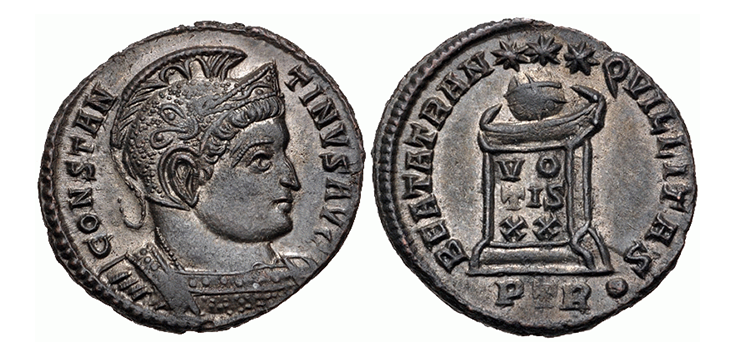Constantine the Great AE Follis
Constantine the Great was the first Christian emperor of Rome. Nonetheless, many of the coins issued during his reign still incorporated pagan designs.

Reign of Constantine
Constantine I, also known as Constantine the Great, ruled the Roman Empire from AD 306 and 337. He rose to power during a time of civil war, becoming the Western Roman emperor after the death of his father. Following a vision, Constantine converted to Christianity. In 313 A.D., he issued the Edict of Milan, which proclaimed that Christians were free to worship throughout the Roman Empire.
In 324 A.D., Constantine defeated Licinius, the emperor of the Eastern Roman Empire, uniting the entire Roman Empire under his control. He went on to found the city of Constantinople on the site of Byzantium and make it the new capital of the Roman Empire. During his time as emperor, Constantine worked to advance Christianity, resulting in the Nicaean Creed. He also sought to strengthen the Roman Empire and its military, which allowed him to fend off attacks from the Visigoths and the Sarmatians. Constantine died of illness in 337 A.D.
Roman Follis
Emperor Diocletian introduced the follis around 294 A.D. The large coin had a copper core and a five percent silver plate.
By the time Constantine became emperor, the coin was smaller and contained very little silver. In the mid-4th century, Constantine introduced a bronze version of the coin. They are known as the AE1, AE2, AE3 and AE4 follis, with the former being the largest follis (approximately 27 mm in diameter) and the latter being the smallest (approximately 15 mm in diameter).
The obverse of the Constantine AE Follis includes the inscription “CONS TANTINVS AVG” around helmeted and cuirassed bust of Constantine to the right. The reverse designs vary. One version featured the inscription “VIRTVS EXERCIT” to the sides of two captives seated at the base of a vexillum (flag of the ancient Roman cavalry).
Another version of the coin includes the inscription “SOLI INV-I-CTO COMITI” with Sol standing nude, wearing only a chlamys (cloak) over his shoulders and left arm. The sun god is raising his right hand commanding the sun to rise, with a globe in left hand. Yet another reverse design includes the inscription “IOVI CONSERVATORI.” Jupiter is depicted standing left, holding Victory on a globe and scepter. There is a wreath at her left foot.
The coins were minted in various locations across the Roman Empire, including Rome, Antioch, Alexandria, Siscia, and Thessalonica. Each coin includes letters in the exergue of the coins indicating the mint of issue, i.e. SIS for Siscia.
